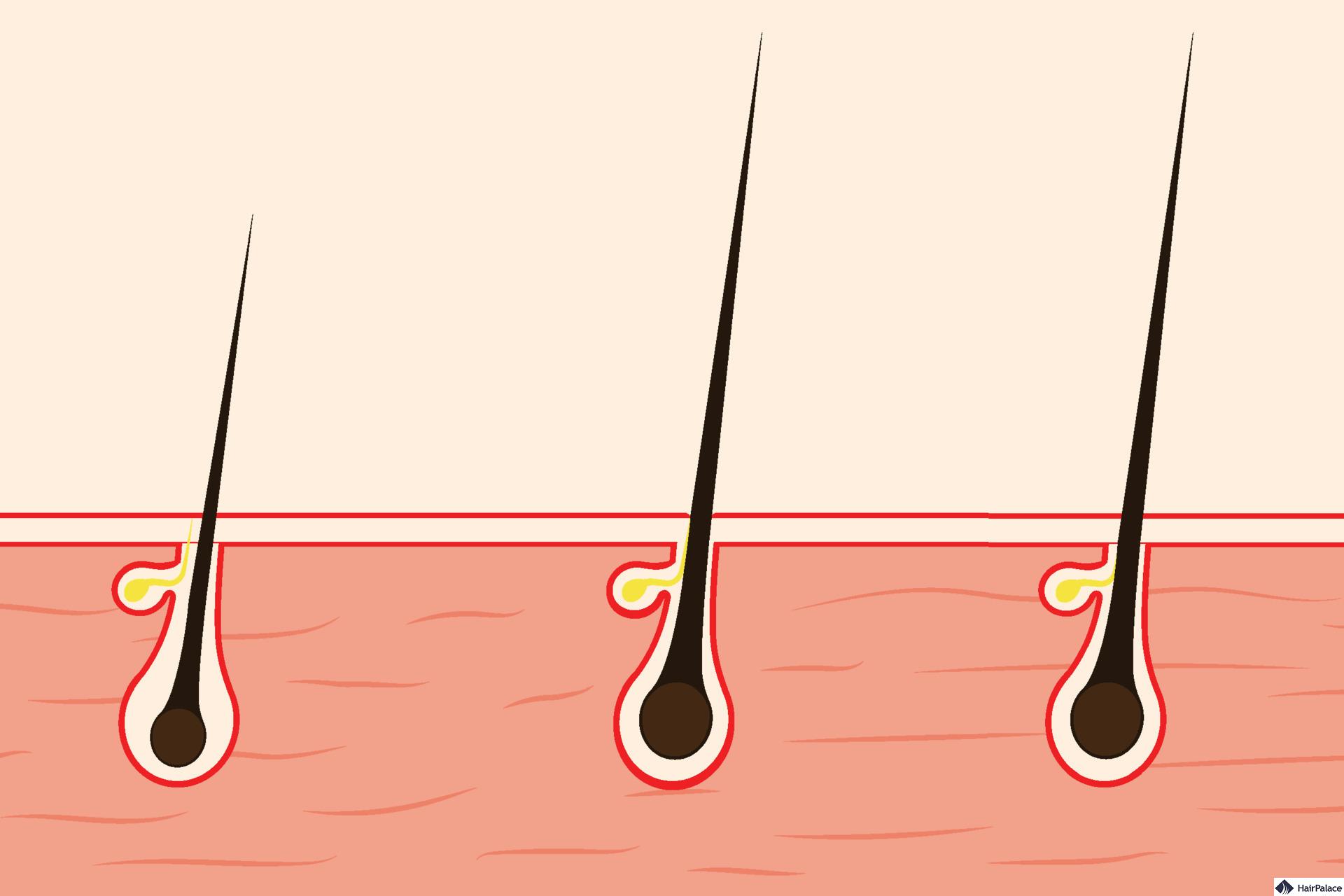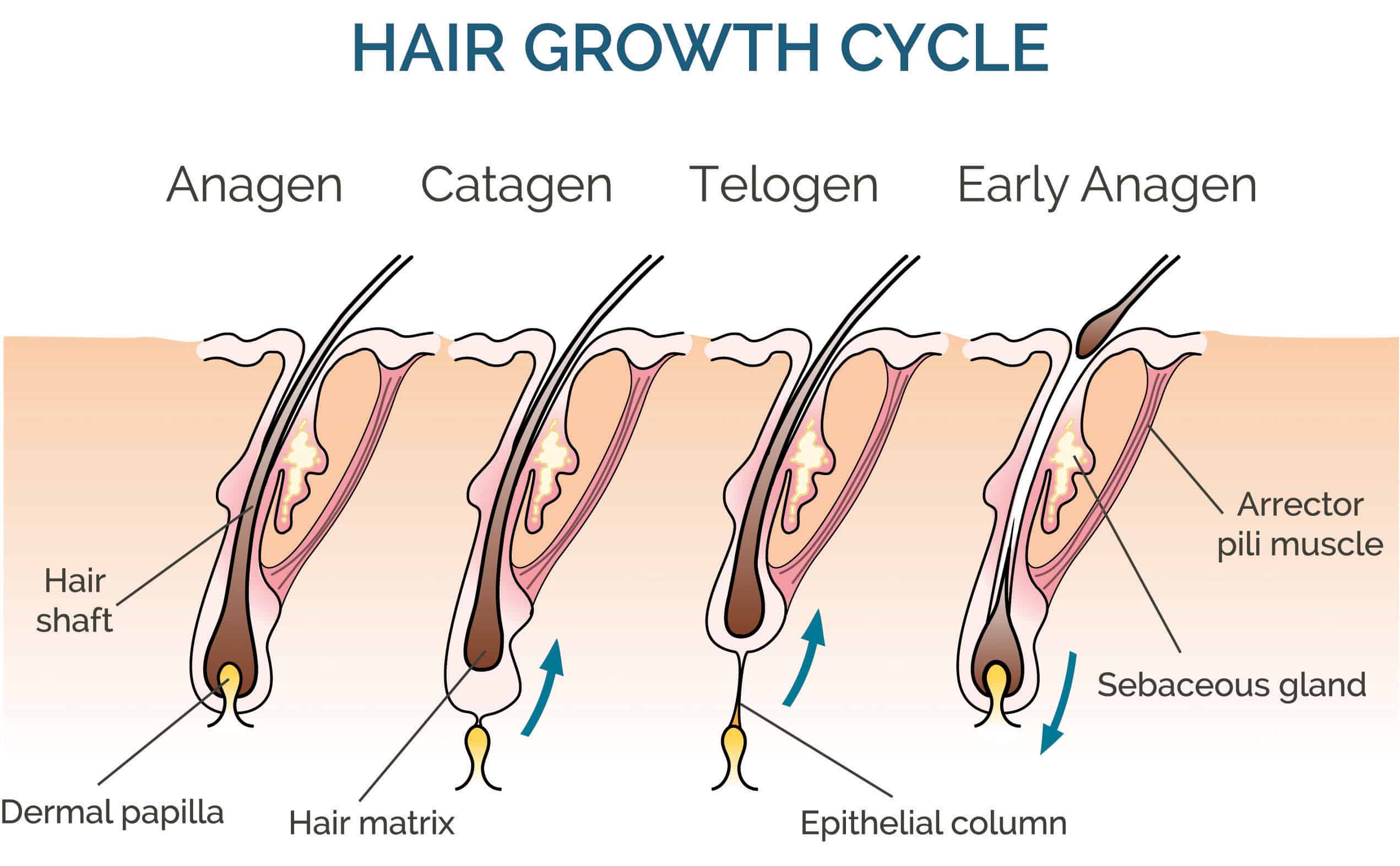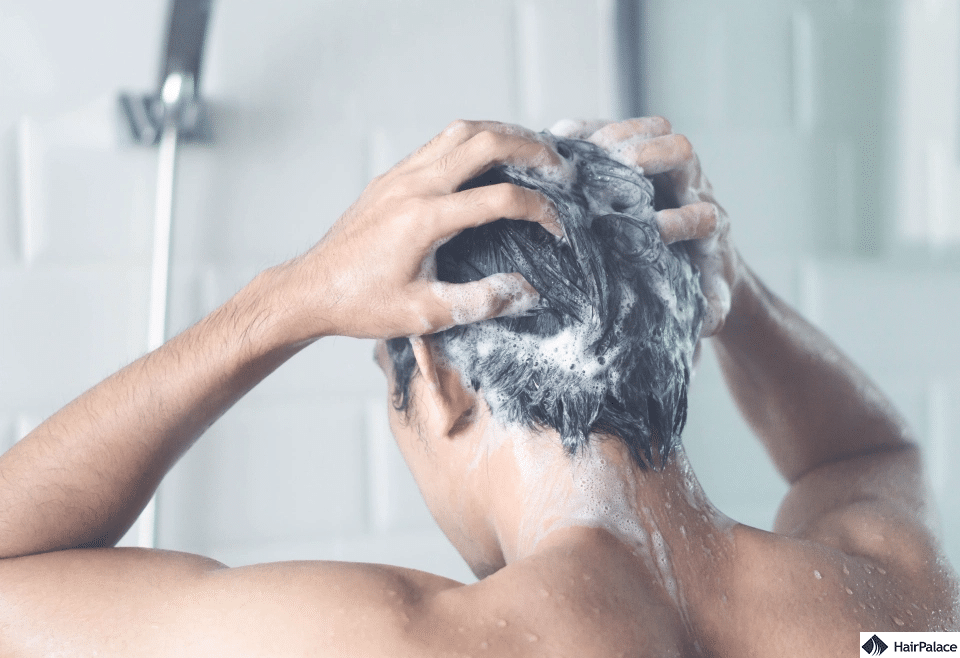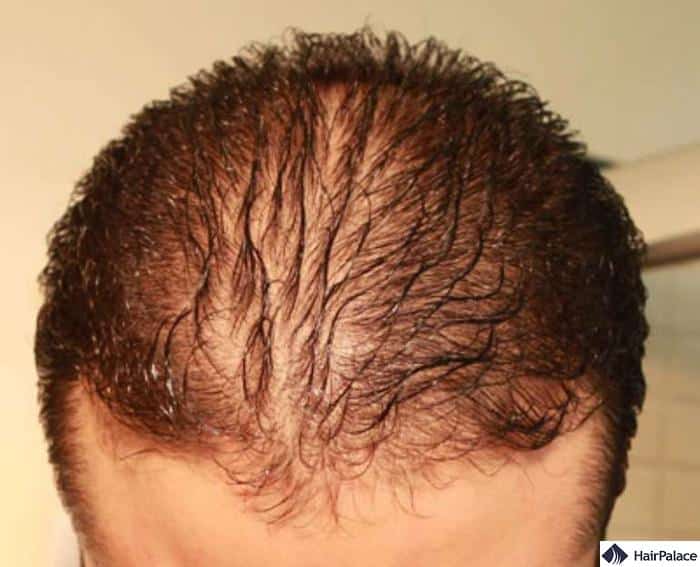Hair Growth Cycle: The 4 Stages of Hair Growth

The hair growth cycle is perhaps one of the most overlooked cycles of our bodies.
We take for granted that hair grows, falls out, and quickly grows back again.
But what if you’re losing a lot of hair at one time?
Maybe the regrowth isn’t quick enough to cover the patches, and you’re worried you’re going bald.
Or perhaps your hair is noticeably thinner, and you want to take action now – before it’s too late.
Understanding how exactly hair grows and the four stages of its lifespan is vital to supporting your hair growth and separating average hair loss from something more sinister.
This article will explore everything you need to know about the different stages of hair growth.
We’ll explain each of the four phases and highlight ways you can help support each hair during this process.
- Anagen phase
- Catagen phase
- Telogen phase
- Exogen phase
- How to keep your hair healthy
- What disrupts the hair cycle?
- How to stimulate hair growth
1. Anagen
The first stage in the growth cycle of hair is the anagen phase, lasting between 2 and 7 years.
It is also known as the growth phase, as during this time, cells inside the hair bulb will divide, creating new hair and developing the hair shaft.
Hair follicles will continue to push out hair strands until cut, fall out, or reach the end of their life expectancy.
The length of the anagen stage determines your hair strand’s maximum length; e.g., a shorter-than-expected phase will result in much shorter hair, and a longer phase will result in long hair.
Some anagen follicles, such as eyebrows or pubic hair, may have shorter cycles than scalp hair.
Factors that influence how long the growing phase lasts include your age, diet, and genetics.
Hair will grow incredibly slowly daily, between 0.3mm to 0.4mm, or 6 inches annually. Up to 90% of hair can be in the anagen phase at any time.

2. Catagen
The second phase is the catagen phase, also known as the transitional phase.
On average, about 5% of your hair is in the catagen stage of hair growth at any time.
This is much shorter than the anagen phase, lasting only 2 to 3 weeks.
During this time, the hair follicle shrinks, and hair begins to slow down growth, eventually stopping altogether.
The hair will detach from the blood supply found within the follicle but will remain inside the follicle as “club hair.”
3. Telogen
The telogen phase is also known as the resting stage.
Anywhere from 10-15% of your hair will be at this stage at a given time.
The resting period can last up to 3 months.
Club hairs will remain dormant and will neither grow nor fall out.
New hairs will begin to develop in follicles where hair was released during the catagen phase.
While some experts maintain there are just three stages to hair growth, and that the telogen stage is both the shedding and resting phase, many now see a need to create a fourth stage to explain the changes that happen during the shedding process properly.
4. Exogen
The final stage is the exogen hair phase, also known as the shedding phase.
Old hair will detach and fall out, and the hair follicle will return to the growth phase to begin the process anew, creating new hair.
You stand to lose anywhere from 100 hairs daily because of the exogen hair cycle phase.
While that number does seem high, this is a normal amount we all go through.
If you notice an increase in shedding, this can signify you’re developing a condition or an external factor, like stress, is severely affecting your hair.
How to keep hair follicles healthy
Although certain factors of hair growth, like genetics and hormones, can essentially be out of your control, there are ways you can support and promote healthy hair relatively simply through your daily lifestyle.
Below are some tips on how you can encourage your active hair growth cycle and reduce potential damage, breakage, and early shedding:
1. Proper nutrition

Every part of your body needs healthy nutrition to function at its best, and your hair is no exception.
The hair shaft is made up of a fibrous protein called keratin.
It would be best to focus on increasing your protein levels to optimise keratin production.
Protein-rich foods you can easily swap into your diet include beans, legumes, fish, and lean meats.
Additionally, other vitamins may greatly benefit your quality and quantity of your hair.
Try to increase your levels of Vitamin B9 (folic acid), Vitamin B12, Vitamin C, and Vitamin D.
Furthermore, consider essential minerals like zinc and iron to improve circulation and reduce inflammation.
2. Reduced stress

You don’t need us to tell you how devastating stress hormones can affect our body, affecting everything from our blood pressure and breathing to mood and the quality and quantity of our hair.
Three main conditions have a link to high levels of stress. They are:
- Telogen effluvium: high-stress levels can push hair strands into the telogen phase earlier than expected, increasing the amount of hair you stand to lose through hair shedding.
- Trichotillomania: this psychological condition is the sudden urge to pull out your hair from the scalp or other body parts. Pulling intensifies as stress levels increase.
- Alopecia areata: this autoimmune condition is when your body’s immune system attacks healthy hair follicles, causing small bald patches to develop across the scalp. Severe bouts of stress can trigger it.
So, how can you reduce stress? Many people incorporate daily yoga and meditation into their routines, breathing techniques, exercise, and counselling if anxiety is severe.
3. Proper hair care

Practising the best haircare routine ensures that your hair is clean, revitalised, and ready to sprout new growth.
You may need to invest in several products to find the ones which work best for you.
One of the most important considerations is the shampoo you’re using.
Try to source a brand designed with your hair type in mind (dry, fine, colour-treated, etc.)
Afterwards, you should also pick a complementary conditioner that helps bolster your hair further.
You should also pay attention to your technique and how you wash your hair. Avoid very hot water as this can damage strands.
Also, avoid using a blow dryer on a high setting; opt for towel drying whenever possible.
What disrupts the hair growth cycle?
Like any bodily function, some can negatively influence hair growth, including slowing it down or preventing it from moving forward.
Depending on the severity and combination of factors, you might experience gradual hair thinning, sudden hair loss, patchy hair loss, or even scarring hair loss.
The factors influencing the hair follicle growth cycle include:
- Poor nutrition: without the necessary nourishment, hair will not grow strong.
- Hormonal changes: periods like pregnancy can alter the rate of hair growth
- Stress: this can cause hair to enter the resting phase earlier than expected
- Medication: specific side effects can impede hair growth
- Scalp infections: hair follicles can become damaged and unable to produce new hair
- Illness: certain diseases, including autoimmune conditions, can limit hair growth.

How to stimulate hair growth?
Healthy hair growth is pivotal to ensuring you have a thick, full head of hair.
Any disruption to the cycle can lead to thinning hair, early hair loss, and complete baldness.
But no matter how well our hair growth cycle understanding is, sometimes our scalp needs additional support.
Thankfully, there are several ways to stimulate and support new growth.
So whether you’re currently suffering from temporary or permanent hair loss, or want to be preemptive in your haircare, consider the following treatments:
- Laser therapy
- Rogaine
- Finasteride
- PRP therapy
- Hair growth products
- Scalp massage
Are you looking for a permanent solution to your hair loss problems?
Then you should consider a hair transplant.
At HairPalace, our team of expert surgeons and technicians use state-of-the-art technology to ensure a quick recovery and, most importantly, thick, natural-looking results.
If you want to learn how you can save up to 70% on your future hair transplant surgery, contact us today!
FAQ
A complete growth cycle can take anywhere between 3-7 years, from beginning to end. Hair typically grows incredibly slowly during this time, at a rate of about 1cm every 28 days.
At any one time, parts of your hair will be in one of the four stages of the growth cycle. Anagen hairs have full pigment and long, covered roots. Catagen hairs detach from the base of the follicle. Telogen hairs have club-shaped roots. Exogen hairs shed. It’s normal to lose 50-100 hairs daily during this phase.
Many things affect the cycle, including your gender, age, genetics and nutrition.
Men’s hair usually grows quicker than women’s, and hair typically grows fastest between 15-30 years of age. After, it begins to slow down.
Although it is a naturally-occurring cycle, certain things can regulate the growth of hairs. A balanced, nutritious diet is one of the most critical ways to support growing hair consistently. The right vitamins and essential minerals ensure your hair has everything it needs to grow and recover.
Trimming hair regularly can remove split ends, which may help in promoting healthier and more uniform hair growth. Furthermore, maintaining a consistent hair care routine with gentle products can support overall hair health.
The cycle of hair growth consists of four main stages. This includes the anagen, catagen, telogen and exogen phases. Each phase plays a role in the development of hairs and the cycle constantly repeats unless something disrupts it.
Telogen effluvium usually lasts 3 to 6 months, with hair gradually regrowing once the trigger is resolved. In chronic cases, it can persist for over 6 months.
You can support a longer anagen (growth) phase through proper scalp care, nutrition, and certain treatments. Key factors include maintaining a balanced diet rich in protein, biotin, zinc, and iron, managing stress, and using topical treatments like minoxidil. Low-level laser therapy (LLLT) and certain peptides (like copper peptides) may also help extend the anagen phase.
Short anagen syndrome is a rare, typically congenital condition where hair grows for a shorter-than-normal period before shedding. It usually does not go away on its own, but some improvement can occur with age. In certain cases, treatments like minoxidil may help prolong the growth phase, though results vary. A dermatologist should evaluate and guide management.
Last medically reviewed on July 15th, 2025
- Rushton DH. Nutritional factors and hair loss. Clin Exp Dermatol. 2002;27(5):396–404.https://pubmed.ncbi.nlm.nih.gov/12190640/
- Alonso L, et al. (2006). The hair cyclehttps://jcs.biologists.org/content/119/3/391
- Thom E. Stress and the Hair Growth Cycle: Cortisol-Induced Hair Growth Disruption. Journal of Drugs in Dermatology : JDD. 2016 Aug;15(8):1001-1004. PMID: 27538002.
- Raechele C. Gathers, Amy J. McMichael, Hair Disorders in Systemic Disease, Dermatological Signs of Internal Disease (Fourth Edition), 2009


